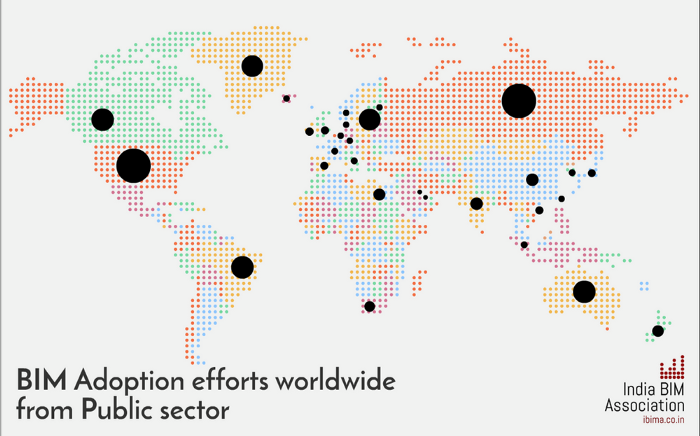In the last edition of the blog, we got to know about ‘what actually BIM is’ & the history of it. Here, in this blog we will discover mainly about BIM implementation & the effectiveness of the same.
The Big Players:– There are mainly three big verticals in which BIM plays a major role, beginning with the Manufacturing vertical to Engineering vertical then lastly about the construction industry. Since last decade, technology has evolved a lot & hence the BIM. The effective implementation and use of BIM remains a major issue for the construction industry. Whilst the technology underpinning BIM has been around for well over a decade BIM implementation and take-up has been relatively slow in the construction industry compared to industries such as manufacturing and engineering.
Countries that are leading with BIM:
Here we look at the top three countries which are implementing BIM the most (Reference Source:- United BIM)
- United Kingdom:- With government support, the UK has radically adopted BIM strategy that has glorified the global image of UK designers, contractors, and other professionals. In April 2016, government mandated BIM Level 2 on all the public projects. UK’s construction industry is one of the most technologically advanced and digitized industry in the world. After the initiative taken by the government, reports have shown that 20 percent of the industry have adopted it successfully and have gained a 12% increase since 2017
- United States:- BIM was initially utilized and successfully implemented in the 1990s all around the world. The United States were the pioneers to get their hands-on BIM development and adoption in the 1970s in the construction industry. BIM isn’t mandated across all the states yet, but it is expected to grow significantly. Wisconsin state implemented and made it mandatory to implement BIM for public projects if equal or above the total budget of $5 million. But it is only in the last three years the adoption of BIM has escalated. The implementation process of digitalizing the construction industry in the US has been slow, and it is because it is in the experimental form. Long term solutions and improvements are still under process.

- France:- France is on the roadmap to digitalize its construction sector, and it has also developed BIM standards for infrastructure project works. In 2014, they initiated by developing 500,000 houses using BIM. They have also allocated funds of around Euros 20 million to enhance the construction industry digitally fully. In the future, implementation of BIM will be mandatory in public projects. Their initiative of the Digital Transition Plan aims at achieving sustainability and optimization of costs. The application will result in the steady growth of the economy by adding value benefits such as environmentally, socially, and safeguarding SMEs.
How exactly is BIM helping companies?
As the project grows in size, so does the complexity of managing it. Traditional 2D models and construction tools that involve manual estimation and calculation cannot fulfill the demands of today’s complex projects. Such manual processes are not only time-consuming but also increase the probability of error and miscalculation.
Now, take a look at the benefits that BIM provides general and specialty contractors:
- Reduced rework and improved constructability
- BIM is highly scalable and can be outsourced
- Eliminates data silos through centralized information and team collaboration
- BIM enables flexible design changes early on in the project
- Reduction in cost and length of construction projects
For sure we can say that BIM is here to stay & will only evolve more & more. In the next article, we will discuss about the future of the BIM & take a guess on the effect of it. Till then stay tuned..!!


